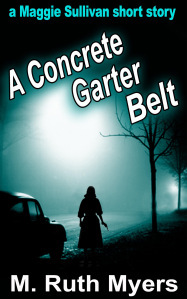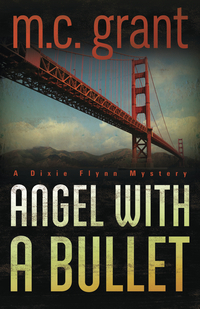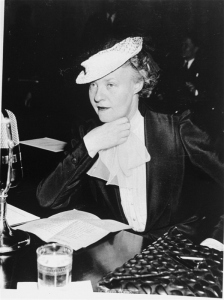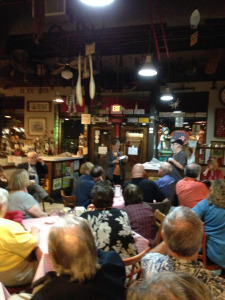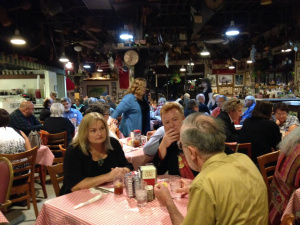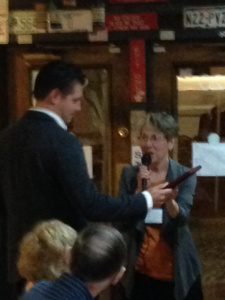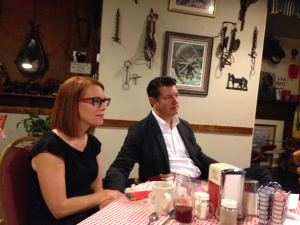M. Ruth Myers's Blog, page 3
January 8, 2016
New Mystery Short Story Set in 1940
“A Concrete Garter Belt”, a new Maggie Sullivan short story, has joined the four novels and one other short story currently in the mystery series. It was previously published in the Private Eye Writers of America anthology Fifty Shades of Grey Fedora, but is now available as a stand-alone.
The private eye’s search for a missing girl takes her into a secretarial service, a common resource used by countless small businesses before the advent of answering machines, Spellcheck and Office 365. It also provides a window into an era when being pawed by the boss was the price young women often paid for keeping their job.
Maggie doesn’t take well to pawing. And she carries a Smith & Wesson.
Filed under: History, News Tagged: 1940s, Greatest Generation, M. Ruth Myers, Maggie Sullivan mysteries, QmBXqR4C3Zv9Rb2kSt8jC9e8QUU, woman P.I., woman sleuth


December 23, 2015
Her Engineering Speeded Work in Kitchens and Defense Plants
As you race around doing your holiday cooking, even if it’s only opening a bottle of wine for guests, take time to raise your oven mitt to the Greatest Generation woman who designed the efficient, modern kitchen we take for granted today. Her name was Lillian Gilbreth, and her many accomplishments include:
Pioneer in time-and-motion studies
First female professor of engineering at Purdue University
First woman elected to National Academy of Engineering (at age 89)
First industrial psychologist
Pioneer in ergonomics
Originator of the “work triangle” now central to kitchen design
Prolific author of papers and books
Along the way, she also gave birth to 12 children.

Photo by Harris and Ewing, from Smithsonian Institution collections, shows Lillian Gilbreth in the 1930s.
Lillian Gilbreth and her husband Frank established themselves as time-and-motion (“efficiency”) experts through industrial studies that broke each component of a process down into how many movements it required, where a worker had to reach for necessary parts or tools, and how many steps the worker had to walk. The duo used stopwatches and short movies to analyze the procedures. Though her name often didn’t appear on them, Lillian wrote many of the papers and books describing their studies and their implications for increased productivity and decreased worker fatigue.
When Frank died unexpectedly of a heart attack in 1924, leaving her with a dozen children to provide for, Lillian found that male executives interested in time-motion studies were far less willing to deal with a woman. A PhD. in psychology had given her more than passing insight into human behavior, however. If she couldn’t gain entry to clients through the front door, she’d go in through the kitchen.
Gas and electric refrigerators were starting to replace the icebox in middle class homes. Companies were suddenly viewing women as potential buyers of these as well as small electrical appliances. Gilbreth’s trained eye saw that even with these new marvels, the kitchens of the late 1920s would remain inefficient – and exhausting – due to inefficient design:
A wall-hung sink and drainboard on one wall, with a cabinet or built in cupboard abutting it.
A free-standing stove on another wall.
The refrigerator or icebox somewhere else.
And bowls, pans, utensils, dishes? Those might be across the room in a pantry, or at best in another cupboard somewhere.

Lillian Gilbreth’s design would make kitchens more efficient than this one newly electrified by the REA. Photo from Franklin D. Roosevelt Presidential Library & Museum.
In 1929, Gilbreth unveiled her Kitchen Practical. It had a counter next to the stove, with food storage above the counter, pots and pans below, and the refrigerator just a few steps away. A multi-use rolling cart provided additional work surface or wheeled dirty dishes to the sink. The resulting layout was the origin of today’s L-shaped kitchen. At the heart of it was what we now call the “work triangle”.
Using the same analysis of movements, equipment and parts (ingredients for a cake) she and Frank had used to study production lines, Gilbreth had created a small, efficient workspace that required very few steps. A few years later, testing a slightly different version of the Kitchen Practical, a cake was baked with identical ingredients in an old style kitchen and the Gilbreth design. The number of steps the cook had to move had dropped from 281 to 45.
With her expertise now well established, Gilbreth soon found her services in demand by the U.S. government from the Great Depression through World War II and the Korean War. In 1930 President Herbert Hoover tapped her to chair the women’s division of the Emergency Committee for Employment where she created a nationwide program that created new jobs. During World War II she oversaw conversion of factories to defense plants and studied workflow to make them more productive.
Today, most readers who know anything at all about this remarkable woman know her from a pair of books by two of her children: Cheaper by the Dozen and Belles on their Toes. With fine humor they describe growing up in a household with two working parents who ran studies on the most efficient way for them to shower, followed by one muddling on creatively without their father.
Private eye Maggie Sullivan uses snippets of knowledge about Gilbreth’s work in Shamus in a Skirt. What the fictional detective didn’t know was that she and Gilbreth shared one thing in common: Neither could cook.
HERE’S THE DEAL:
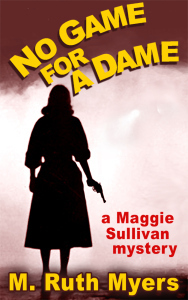
Haven’t read a Maggie Sullivan mystery?
Try the first one free.
Filed under: History Tagged: 1930s, Greatest Generation, Lillian Gilbreth, M. Ruth Myers, Maggie Sullivan mysteries, modern kitchen, QmBXqR4C3Zv9Rb2kSt8jC9e8QUU


December 1, 2015
Early Women Detectives & Policewomen
Occasionally – perhaps once in 150 reviews – a reader expresses doubt that a woman PI like Maggie Sullivan could have existed in the late 1930s or 40s. Admittedly they were a rare breed, but women private detectives and policewomen were around in that era and well before.
The best known among them is without doubt Kate Warne. She is widely listed as the first woman private eye, having been hired by the famous Pinkerton agency in 1856. Described in their records as slender and of medium height, she presented herself as a widow, age 23, when she applied to work there. She went on to become one of Pinkerton’s most valued agents. Among her accomplishments was helping to foil an assassination attempt on the newly elected president, Abraham Lincoln, in 1861.
Read more about Kate Warne on the Library of Congress blog.
Cora M. Strayer operated her own private detective agency on the South Side of Chicago in the early 20th century. She first ran an ad for her services in 1902 and used her four-room apartment over a tavern as her office. (The tavern downstairs was home to illegal gambling and bookmaking operations.) In 1905 she ran an ad for her agency in Chicago’s city directory. It included her photo – and what a nice Victorian lady she appears. With some ups and downs and colorful detours, she continued to advertise her services as a private detective until 1930.
See what Cora looked like, as well as her ads, in a rollicking 2012 blog post by Paul Reda.

Policewomen in Dayton, OH, circa 1918. Lulu Sollers is on the left.
Dayton, Ohio, where my Maggie Sullivan series is set, established its “women’s police force,” in 1914. Officially titled the Bureau of Policewomen, it reported directly to the Director of Public Safety. Previously the city had employed jail matrons to interact with female prisoners. When policewomen came on the scene, they were another breed entirely. They handled probation cases, conducted some forms of surveillance and gave talks to community organizations. With time their duties expanded to checking dance halls, investigating juvenile crime and more. They wore badges like their male counterparts, except that the women’s badges were two-thirds the size.
In 1914 Annie R. McCully, who already was working as a matron, became Dayton’s first full-fledged policewoman. She was put in charge of organizing the new Bureau. That same year, Lulu Sollers pinned on her badge as well. Four years later she became supervisor of the Policewomen’s Bureau, a position she held until 1944. In 1929 the city hired its first African American policewoman, Dora Burton Rice.

Policewoman’s badge, also known as a ‘shield’, from Dayton, OH.
Photos are courtesy of the Dayton Police History Foundation.
Down the road in Vinton County, Ohio, voters in 1926 elected the state’s first female sheriff. Her name was Maude Collins, and she was elected “in a landslide”. She filled the vacancy left when her husband, Sheriff Fletcher Collins, was shot and killed at close range. A mother of five, she carried a gun and had impressive detective skills. Her solving of a double homicide got her a write-up in the national Master Detective magazine.
See a photo of this attractive young sheriff and read a fuller account of her accomplishments at the Vinton County Convention &Visitors’ Bureau website.
Good historical fiction often is inspired by real-life women such as these, women who though few in number actually existed. One thoroughly fun example is the new Laurel Private Eye series just launched by Shannon D. Wells about a woman Pinkerton detective in Texas in the 1930s. It came into being because a several-generations-removed relative of the author was — you guessed it — a woman Pinkerton in Texas in the 1930s.
— HERE’S THE DEAL —
Now through Dec. 6 A Touch of Magic is discounted to 99c on Amazon, B&N, iTunes and Kobo. It’s not a Maggie Sullivan mystery, but it’s a fast-paced thriller of romantic-suspense originally published by Dell.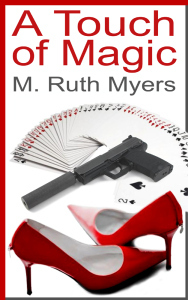
A dazzling sleight-of-hand artist is recruited by the State Department to pit her skills – and wits – against a master terrorist.
Filed under: History, Uncategorized Tagged: American women, Dayton, detective novels, history, M. Ruth Myers, mystery, OH, policewomen, QmBXqR4C3Zv9Rb2kSt8jC9e8QUU


November 15, 2015
Crossing Gender Lines to Create a Woman Investigator
Grant McKenzie leads a double life, as a thriller writer under his own name and as author of the Dixie Flynn mysteries under the name M.C. Grant. The latter series features a young investigative journalist for an online news site who’s as tough as she is rumpled. Beauty With a Bomb, the third book in the series, was a finalist for this year’s Shamus Award for best paperback original P.I. novel — and is it a page-turner!
This year’s Shamus Awards Dinner gave me an opportunity to become acquainted with Grant and his wife, Karen. He generously agreed to be interviewed for this blog.
Ruth: You already were well established as a thriller writer when you started the Dixie Flynn series. What made you decide to tackle something a good bit different?
Grant: The Grant McKenzie novels are real edge-of-your-seat thrillers written in third-person, but I have always been a fan of crime noir that tends to be written in first-person. The Dixie Flynn series allows me to explore a genre that I adore, and write it from a different perspective. (I also write them in present tense, which is different from the Grant McKenzie novels, too).
Creating a series also allowed me to introduce quirky characters that can grow with each book, so that a minor character in one book could take on a larger role in the next book, while another character sits on the sidelines. Plus, as becomes very clear in the Dixie books, the ramifications of each book plays a toll on Dixie, shaping her in dark and dangerous ways. That’s why I always suggest that readers start the series at Angel With A Bullet before moving on to Devil With A Gun and Beauty With A Bomb.
Ruth: Why a female protagonist?
Grant: Dixie is such a fun character to write. She’s feisty, hard-headed and doesn’t pull her punches – either verbally or physically. I decided to make Dixie female in order to give her a vulnerability that can be difficult to create in a male character. Noir readers don’t necessarily like to see weakness in their male characters, but it is those moments of fear, doubt and despair that can really show character. Despite her toughness, I really wanted Dixie to have those moments when she got in too far over her head and the reader could really fear for her life. I also wanted to bring in her troubled love life in a humorous manner, and writing that from a woman’s perspective was just plain fun. There is a scene in Angel With A Bullet where Dixie describes two police officers by the seat of their pants that always gets a giggle from readers.
Ruth: It seems to me that women writers are more likely to cross gender lines and write a series with a male protagonist than men are to base a series around a woman. Of course there are exceptions, like J.A. Konrath, Alexander McCall Smith and the late Robert Parker, but in general, do you think that’s true?
Grant: I do. I think a lot of female writers believe that their work will be taken more seriously by the publishing industry if it features a male protagonist — and that may have been true at one point, though, fortunately, not anymore. While male writers choose to write in a female voice as both a challenge and for the sheer fun of it. There are likely male writers who wouldn’t be comfortable ever writing in a female voice, and the same trepidation is likely true of some female writers, too.
Ruth: Is the Dixie character based on anyone?
Grant: The character isn’t based on anyone, but the name is. When I first emigrated to Canada as a teenager, I met a girl named Dixie Dash who was the roller-skating queen of the high school I attended. As a Glasgow Scot, roller skating was as foreign to me as Canada was, and Dixie was kind enough not to mock my absolute uselessness at the sport. At the same time, I was reading S.E. Hinton and Gregory Macdonald, and just beginning on my journey to Raymond Chandler, Dashiell Hammett, and Mickey Spillane, etc. I always thought Dixie Dash was such a cool name and it stuck with me. Unfortunately, my publisher Midnight Ink, felt that Dixie Dash sounded too corny, so the name was changed to Dixie Flynn. In my heart, however, she is Dixie Dash.
Ruth: Both you and your wife are former journalists, correct? Did that influence your decision to let Dixie be an investigative journalist rather than a regular P.I.?
Grant: Yes. I spent over 30 years in the newspaper business, and have very fond memories of all the characters that I worked beside over the years. The business has changed a lot in recent years and Dixie mourns those early days when gutter-rumpled creatures could shuffle into work on a cloud of stale beer fumes and write incredible journalistic poetry. I like to close my eyes to those later paycheck years in journalism and try to remember when I was young, naive and wanted to change the world. Dixie is jaded, but she still has those dreams and ideals in her heart.
Ruth: What’s the most difficult part of the writing process for you?
Grant: Finding the time. Working full-time for a homeless shelter and trying to write books is a difficult task. I dream of having a break-out book that puts enough money in the bank that I can actually make writing my full-time occupation. There are stories I haven’t told simply because I couldn’t find time.
Ruth: What’s your current project? Thriller? Dixie?
Grant: I’m busy writing a new Grant McKenzie thriller that I’m very excited about. Polis Books is publishing three of my novels in 2016: The Fear In Her Eyes in April, K.A.R.M.A. in July, and the one I’m currently writing, tentatively titled The Butcher’s Apron, in September. It’s going to be an exciting year as I believe these three are some of the best thrillers I have ever written.
Ruth: If you were going to choose a line of work other than novelist, what would it be?
Grant: I’ve always fancied running an Exotic Cat Farm in Belize – the furry pet kind not a Nevada bordello – but I don’t think there would be much money in that. Apart from that, anything creative, really. Anyone hiring Dreamers?
COMING NEXT: Early women P.I.’s and police women
HERE’S THE DEAL:

Try the first book in the Maggie Sullivan series FREE.
Filed under: Authors Tagged: detective novels, M. Ruth Myers, private eye novels, QmBXqR4C3Zv9Rb2kSt8jC9e8QUU, woman P.I., woman sleuth


November 5, 2015
Women Clash on Eve of WW2
In the two years before the Pearl Harbor attack, Americans were divided over whether the country should get involved in the war against Hitler. Nowhere was this split more evident than among American women.
In 1940 and ’41, when politics was still largely a man’s game, women who never before would have done something as indecorous as marching with signs — let alone acting up in public — took to the streets. Others took to the airwaves of that new medium, radio. Some testified before Congress.
On one side were the Isolationists, women who believed America should stay out of the war in Europe. Under the umbrella term the ‘Mothers Movement’, they organized local groups with various affiliations across the country. Dressed in black and wearing veils, they screamed and spat on members of Congress who didn’t share their views. They held vigils and wailed. In Washington, DC, they hanged an effigy of Sen. Claude Pepper (who supported helping Europe) in front of the Capitol.
On the opposite side were the Interventionists. They believed America had a duty to help allies, defend democracy and fight fascism. Among their numbers, in addition to ordinary women, were women educators and journalists. One of the most prominent was Dorothy Thompson, who wrote a newspaper column as well as one in Ladies Home Journal and had a weekly radio program on NBC. In September of 1939 Thompson testified before a Senate committee, urging them to sell arms to Great Britain and France.
This clash of positions split families.
Anne Morrow Lindbergh, author and wife of the famous aviator, was an ardent Isolationist and the darling of the Mothers Movement. She and her husband had been guests of top Nazi officials.
Her mother, Elizabeth Cutter Morrow, a noted educator who served as first woman head of Smith College, was an active Interventionist. She did a radio speech in favor of American involvement in World War II, and was the target of threats from the Mothers Movement.
Anne’s older sister, Elisabeth, likewise strongly supported the Interventionist cause.
For women, one particular issue added fuel to the disagreement: efforts to enact the country’s first ever peacetime draft. President Franklin Delano Roosevelt’s military advisors, alarmed at how ill-prepared the country was for war, wanted to start peacetime conscription so at least some trained fighting men would be available if needed.
On Sept. 14, 1940, both houses of Congress passed the Selective Service Act. At the end of the following month, one week before Election Day, the first draft numbers were drawn. Isolationist women continued to rally. If only they could prevent FDR’s re-election, they thought, their sons and other loved ones would never be thrust into battles on the other side of the world.
But he was and they did.
Photo credit: National Archives and Records Administration
** HERE’S THE DEAL **
99c thru 11/9

Maggie Sullivan mystery Number 4
Filed under: History Tagged: 1940s, American home front, American women, M. Ruth Myers, QmBXqR4C3Zv9Rb2kSt8jC9e8QUU


October 20, 2015
Blog Remodeling
Filed under: Uncategorized Tagged: M. Ruth Myers, Maggie Sullivan mysteries, QmBXqR4C3Zv9Rb2kSt8jC9e8QUU


October 16, 2015
Private Eye Writers & Shamus Awards Dinner
The Shamus Awards dinner, hosted by Private Eye Writers of America, is my favorite part of the annual Bouchercon world mystery convention. All those authors of P.I. fiction, from the big names to a sprinkling of newbies, crowded into one room. They’re not quite as seedy as their print creations, but they do have a certain swagger that sets them apart.
This year’s bash was at Big Ed’s City Market in Raleigh, NC. No shots were fired.
Henry and I enjoyed the chance to become acquainted with Canadian thriller writer Grant McKenzie and his wife Karen, both former journalists. Grant’s novel Beauty with a Bomb, part of the Dixie Flynn series which he writes under the name M.C. Grant, was a finalist in the Best Paperback Original category. I had trouble putting it down, and am now a firm fan of this series featuring a kick-ass young investigative journalist for a news website.
It was my pleasure to present the Shamus Award for Best Indie P.I. Novel of 2014 to Trace Conger for his novel The Shadow Broker. He’s shown here receiving the award, and in the audience with his wife Beth.
Here are this year’s finalists and winners in the various categories. *=winner
BEST HARDCOVER P.I. NOVEL
The Hollow Girl by Reed Farrel Coleman
The Silkworm by Robert Galbraith
Toyko Kill by Barry Lancet
* Hounded by David Rosenfelt
Peter Pan Must Die by John Verdon
BEST FIRST P.I. NOVEL
* Invisible City by Julia Dahl
Bad Country by C.B. McKenzie
Last of the Independents by Sam Wiebe
Wink of an Eye by Lynn Chandler Willis
City of Brick and Shadow by Tim Wirkus
BEST ORIGINAL PAPERBACK P.I. NOVEL
The Detective and the Pipe Girl by Michael Craven
Beauty With A Bomb by M.C.Grant
Critical Damage by Robert K. Lewis
Street Justice by Kris Nelscott
* Moonlight Weeps by Vincent Zandri
BEST P.I. SHORT STORY
* “Clear Recent History” by Gon Ben Ari in Tel Aviv Noir
“The Ehrengraf Fandango ” by Lawrence Block in Defender of the Innocent
“Fear Is The Best Keeper of Secrets ” by Vali Khalili in Tehran Noir
“Mei Kwei, I Love You” by Suchen Christine Lim in Singapore Noir
“Busting Red Heads” by Richard Helms in Ellery Queen’s Mystery Magazine
BEST INDIE P.I. NOVEL
* The Shadow Broker by Trace Conger
Nobody’s Child by Libby Fischer Hellmann
Played To Death by BV Lawson
The Kids Are All Right by Steve Liskow
Get Busy Dying by Ben Rehder
A Lifetime Achievement Award was presented to Parnell Hall.
M. Ruth Myers writes the Maggie Sullivan mystery series.
Filed under: Authors, News Tagged: detective novels, M. Ruth Myers, P.I. fiction, private eye novels, private investigator novels, QmBXqR4C3Zv9Rb2kSt8jC9e8QUU, Shamus Awards


September 26, 2015
Launch Party for New Mystery
Come on over to my Facebook page for a chance to win BOOKS, CHOCOLATES, and CD’s of traditional Irish music. We’re celebrating the launch of Shamus in a Skirt, fourth book in the Maggie Sullivan series. It’s now available from most ebook retailers.
Besides periodic prize drawings, there also are assorted videos of Irish music by folks I know — just tunes, no songs.

Maggie Sullivan mystery Number 4
The festivities continue until midnight EST tonight (9/26).
Filed under: Authors, News Tagged: detective novels, M. Ruth Myers, Maggie Sullivan mysteries, mystery, QmBXqR4C3Zv9Rb2kSt8jC9e8QUU, woman sleuth


August 28, 2015
Maggie Sullivan mystery #4 coming soon
Coming in September

Maggie Sullivan mystery Number 4
Filed under: News Tagged: detective novels, M. Ruth Myers, Maggie Sullivan mysteries, mystery, QmBXqR4C3Zv9Rb2kSt8jC9e8QUU, woman sleuth


August 7, 2015
Arcade featured in 1930s private eye mysteries
Here’s a recent picture of the now-deserted Arcade which usually is the locale of at least one scene in most of the Maggie Sullivan mysteries. You’ll enjoy the brief account of its history.
Small wonder the spot turns up in my series, what with the detective division of the Dayton police just across the street in one direction and the newspaper building where Maggie’s friend Jenkins works across the street in another. And where else could you get the equivalent of fast food in the late 1930s?

Do click the image in the link to see the dome . The round things that look like satellite dishes are…uh… turkeys.
The Arcade was still a thriving place when I was a young reporter working across the street. Of course the food stalls weren’t as numerous or the offerings as picturesque as in Maggie’s day.
Now a small commercial: Tough Cookie, second book in the Maggie Sullivan mysteries, is discounted to 99c on Amazon & other sites now through Aug. 8.
Filed under: History Tagged: 1930s, history, M. Ruth Myers, Maggie Sullivan mysteries, private eye novels, QmBXqR4C3Zv9Rb2kSt8jC9e8QUU, woman sleuth



